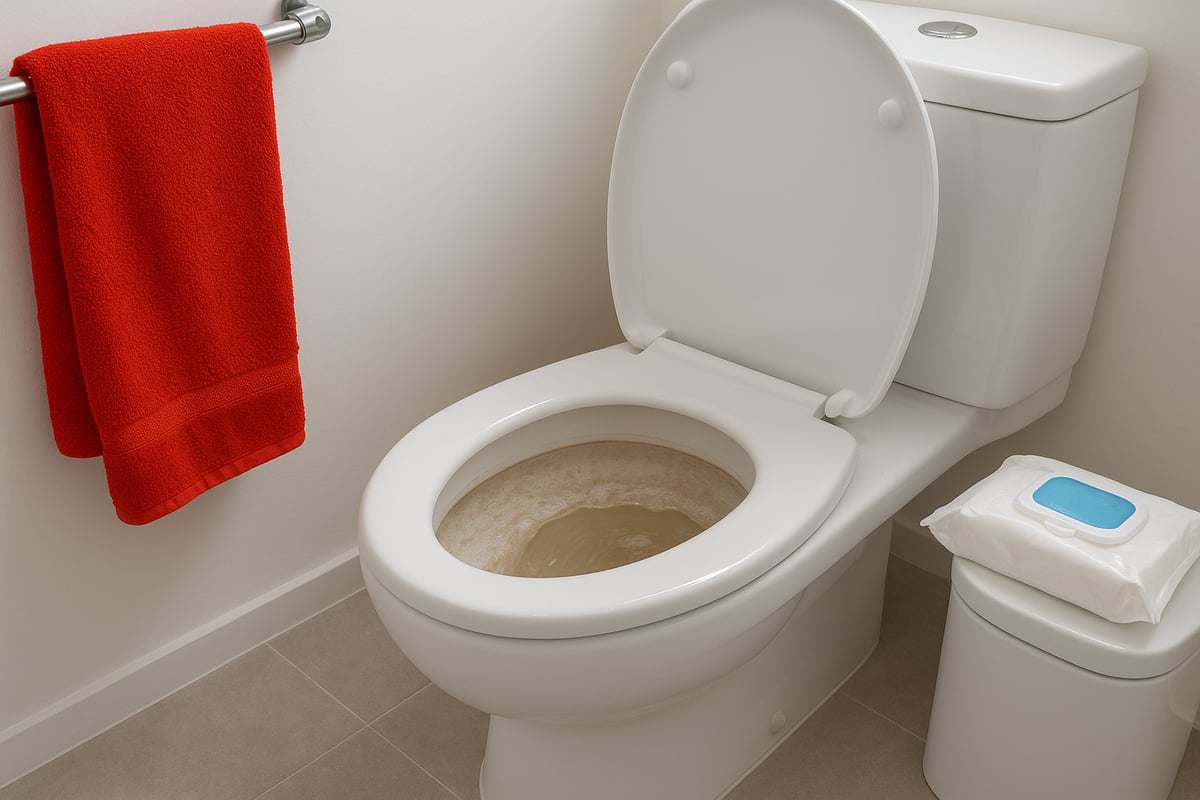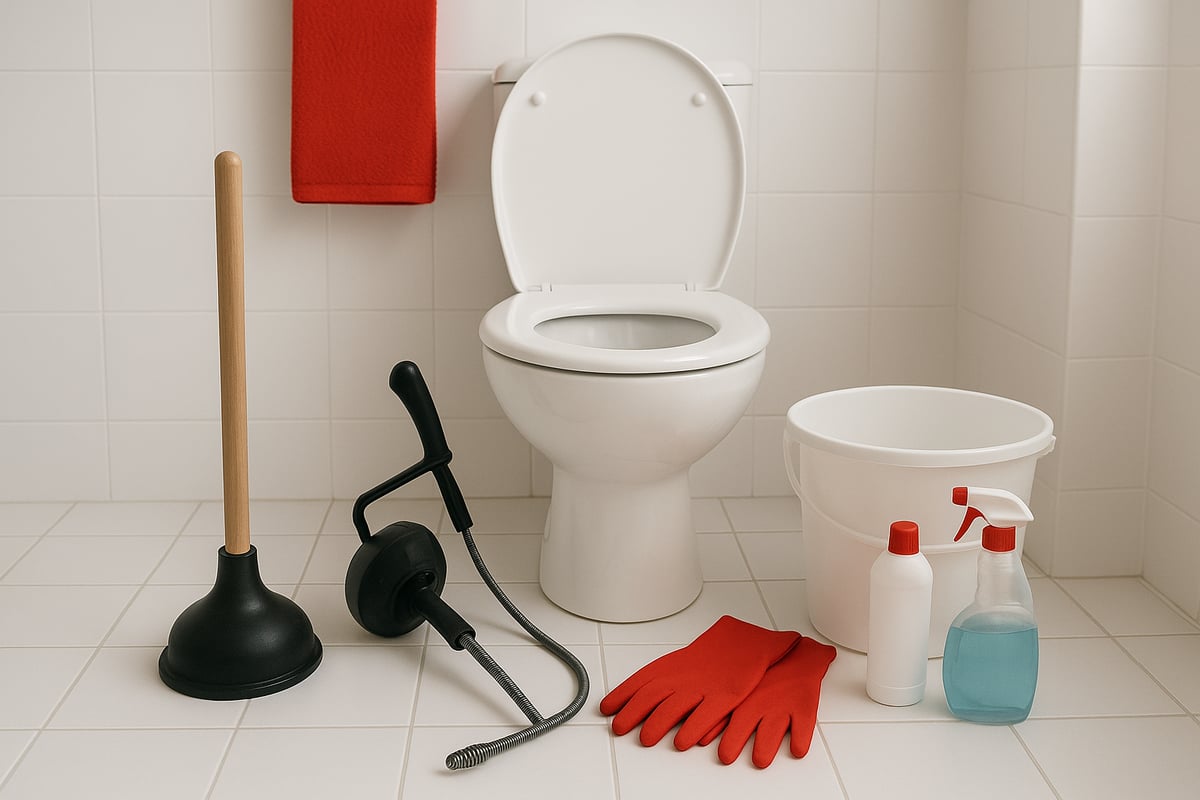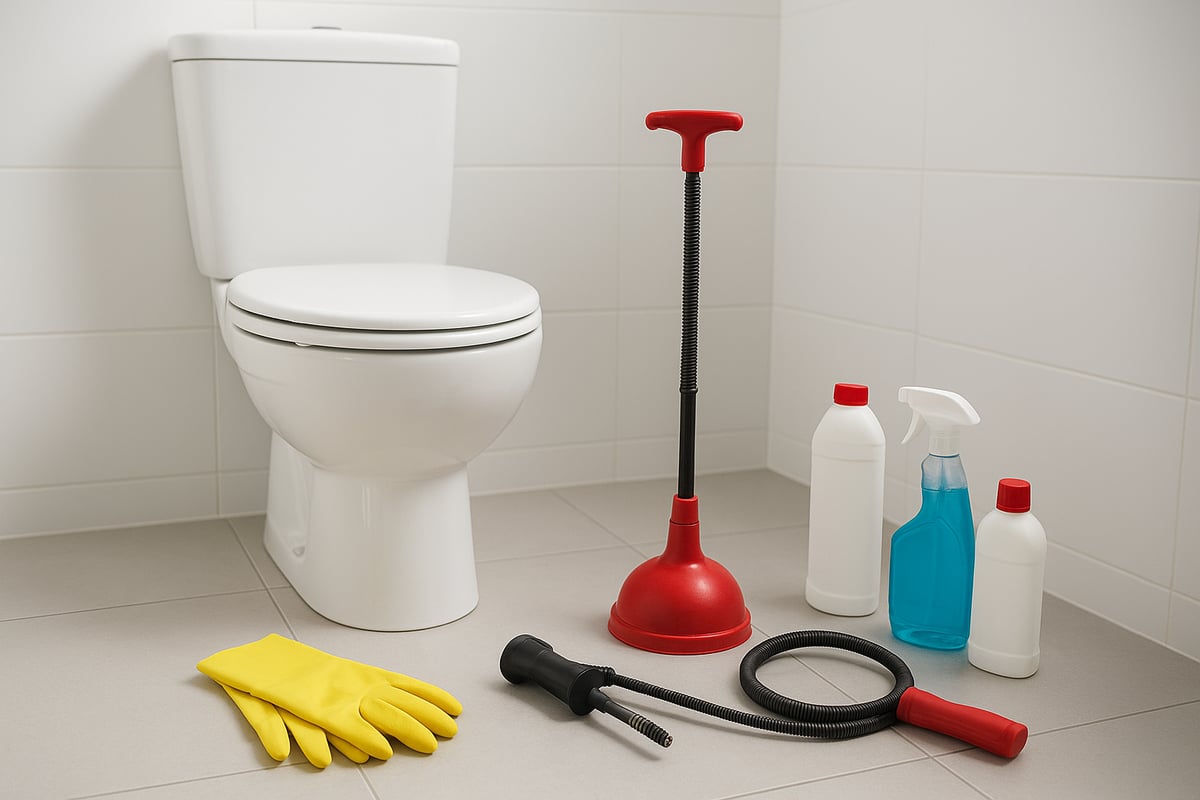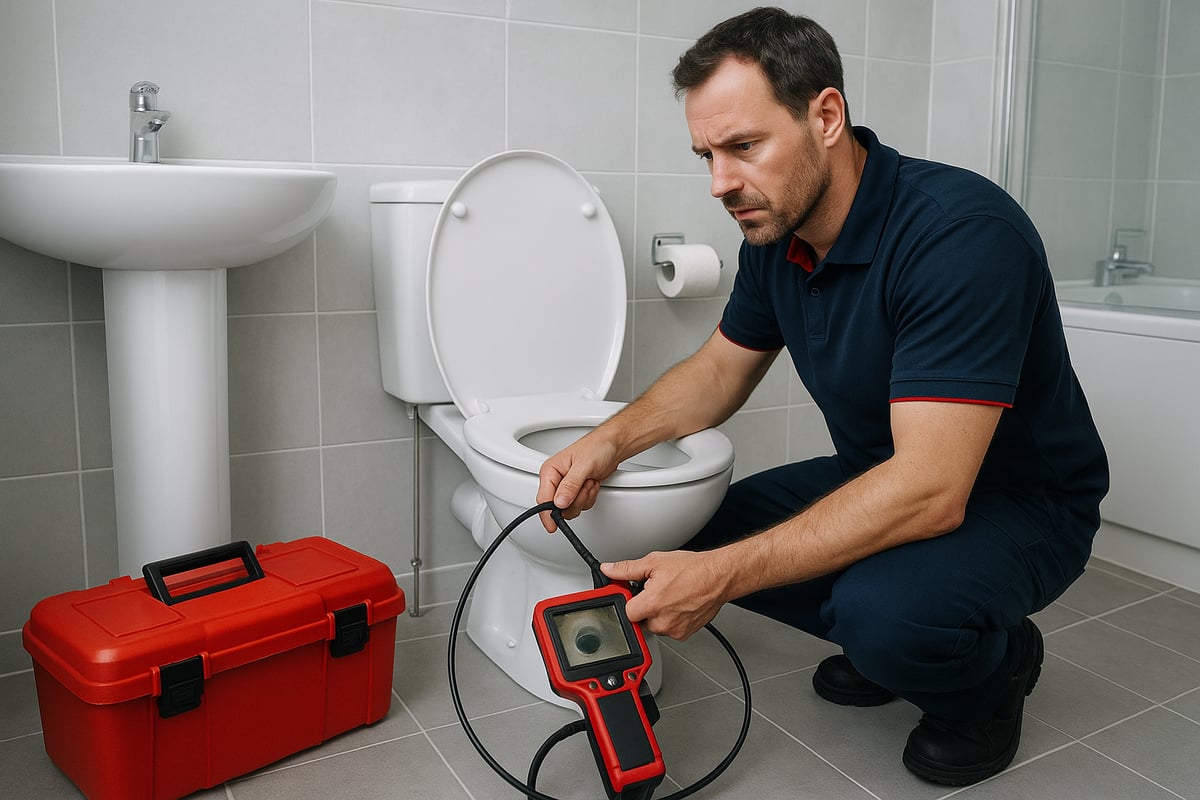Expert Guide To Clear Blocked Toilet In 2025
A blocked toilet is every homeowner’s nightmare, often striking at the most inconvenient times. The frustration and urgency to clear blocked toilet issues can quickly turn a simple problem into a household crisis if not handled correctly.
In today’s modern homes, toilet blockages are more common than you might think, with new plumbing designs introducing their own challenges. This expert guide will empower you with the latest, step-by-step strategies to clear blocked toilet problems confidently and safely in 2025.
You’ll discover the main causes of blockages, essential tools, proven DIY techniques, when to call a professional, and practical prevention tips. Ready to take control? Let’s get started.
Understanding Toilet Blockages in 2025
To clear blocked toilet problems efficiently in 2025, it’s essential to first understand why they happen and how to spot them early. Knowing the main triggers, warning signs, health risks, and environmental impact helps you tackle the issue with confidence.

Common Causes of Blocked Toilets
Blocked toilets in 2025 are usually caused by flushing the wrong items. The top culprits include excessive toilet paper, wipes, sanitary products, and other foreign objects. Modern low-flow toilets, designed to save water, can sometimes make it harder to clear blocked toilet issues since they have less powerful flushes.
Changes in plumbing codes and materials since 2020, such as the increased use of eco-friendly pipes, can also affect how easily a blockage forms. Hard water and limescale build-up are a real concern in many UK regions, narrowing pipes and trapping waste.
A recent UK study on wipes in sewer blockages found that wipes make up over 80% of materials causing blockages in UK homes. This highlights how crucial it is to avoid flushing non-flushable items if you want to clear blocked toilet problems for good.
How to Identify a Blocked Toilet
Spotting a blocked toilet early can save you a lot of hassle. Common signs include slow drainage after flushing, rising water in the bowl, gurgling noises from the pipes, and unpleasant odours in the bathroom. These symptoms can indicate either a partial or complete blockage.
A partial blockage might still let water drain slowly, while a complete one causes immediate backup and possible overflow. Inspect the toilet bowl for unusual water levels or visible obstructions. Lifting the cistern lid can reveal issues with the flushing mechanism.
For harder-to-spot problems, use dye tablets or a few drops of food colouring in the cistern. If coloured water appears in the bowl without flushing, you may have a leak or a slow-forming blockage. Acting quickly helps you clear blocked toilet issues before they escalate.
Health and Hygiene Risks
Toilet blockages are more than just an inconvenience. Stagnant water and trapped waste create ideal conditions for bacteria and germs to multiply. This can pose a risk of contamination, especially if water overflows onto bathroom floors.
Overflowing toilets can cause costly property damage, soaking floors and walls, and even seeping into ceilings below. The longer you wait to clear blocked toilet problems, the higher the chance of mould growth and persistent odours throughout your home.
Prompt action is essential to protect your family’s health. Always use gloves and disinfect surfaces after dealing with a blockage to maintain a safe and hygienic environment.
Environmental Considerations
Many people reach for chemical drain cleaners when trying to clear blocked toilet issues. However, these products can harm septic systems and pollute local watercourses. In 2025, there is a growing trend towards eco-friendly alternatives like enzyme-based cleaners that break down waste without damaging pipes or the environment.
Flushing only human waste and approved toilet paper helps prevent blockages and protects the environment. Avoid pouring fats, oils, and harsh chemicals down the drain. By switching to greener habits, you not only clear blocked toilet problems more safely but also support a healthier planet.
Essential Tools and Preparation for Unblocking Toilets
Unblocking a toilet can feel daunting, but with the right preparation and equipment, you can tackle most issues confidently and safely. Before you attempt to clear blocked toilet problems, make sure you’re set up for success with the essential tools, smart preparation, and proper safety measures.

Must-Have Tools for DIY Toilet Unblocking
To successfully clear blocked toilet obstructions, you’ll need the right tools on hand. Start with a flange (toilet) plunger, designed for a tight seal and improved plunging power compared to standard plungers. A toilet auger, also known as a plumber’s snake, is vital for reaching and breaking up stubborn blockages deeper in the trap.
Don’t forget robust rubber gloves and protective clothing to shield yourself from splashes. Keep a bucket and old towels nearby for water removal and quick clean-up, plus disinfectant for sanitising surfaces afterwards. For tougher jobs, a wet/dry vacuum and enzyme-based drain cleaners can also be helpful. Having these tools ready makes it far easier to clear blocked toilet issues efficiently.
Quick Reference Table: Essential Tools
| Tool | Purpose |
|---|---|
| Flange Plunger | Main tool for blockages |
| Toilet Auger | Reach deeper obstructions |
| Rubber Gloves | Hygiene and protection |
| Bucket & Towels | Clean-up and water removal |
| Disinfectant | Sanitising surfaces |
| Wet/Dry Vacuum | Advanced block removal (optional) |
| Enzyme Cleaners | Eco-friendly maintenance |
Preparation Steps Before You Begin
Preparation is key before you attempt to clear blocked toilet clogs. Start by locating and turning off the water supply to the toilet, usually found behind the cistern. This prevents accidental overflow while you work.
Use a small container or cup to remove excess water from the bowl, placing it in a bucket. Lay old towels or plastic sheets on the floor to protect against spills and splashes. Check for any accessible cleanouts or inspection ports nearby, which can make the job easier if the blockage is further down the line. Careful preparation before you clear blocked toilet blockages will save time and help prevent mess.
Safety and Hygiene Precautions
Safety should always come first when you clear blocked toilet problems. Always wear thick rubber gloves and, if possible, eye protection to shield against splashes. Open a window or use an extractor fan to ventilate the bathroom and reduce odours.
Dispose of contaminated water and waste in a safe, hygienic manner, preferably down a utility sink. Never use kitchen items for toilet work to avoid cross-contamination. Disinfect all tools and surfaces thoroughly after use. Taking these precautions ensures your efforts to clear blocked toilet issues don’t create new health hazards in your home.
When to Avoid DIY Methods
Sometimes, it’s best not to clear blocked toilet problems yourself. If you notice water backing up into other fixtures, multiple drains blocked at once, or repeated clogs even after trying several methods, these are signs of a deeper issue like a sewer line blockage or old, fragile pipes.
DIY methods can worsen the problem or cause damage in these cases. If you’re ever in doubt, consider seeking drainage services for blocked toilets to ensure the blockage is handled safely and effectively. Knowing when to stop and call a professional can ultimately protect your home and save you money.
Step-by-Step DIY Methods to Clear a Blocked Toilet
Unblocking a toilet yourself can be straightforward if you follow proven techniques. In this section, you'll discover practical, step-by-step methods to clear blocked toilet issues safely and efficiently. With the right approach, most minor blockages can be dealt with at home, saving you time and money.

Method 1: Using a Plunger
The classic plunger remains the most effective first step to clear blocked toilet problems. Begin by selecting a flange plunger, which forms a strong seal in the toilet bowl for powerful suction.
- Step 1: Place the flange plunger into the bowl, making sure it fully covers the drain opening. This ensures a tight seal, crucial for the best results.
- Step 2: Start with a gentle push to expel trapped air. This prevents splashback and helps the plunger grip the blockage.
- Step 3: Use a vigorous up and down motion for 15-20 seconds. Keep the seal intact throughout.
- Step 4: Lift the plunger and check the water level. If it drains, try a test flush. If not, repeat the process.
In 2025, up to 90% of minor blockages can be resolved with a plunger alone, making it a must-have tool for anyone looking to clear blocked toilet situations quickly.
Method 2: Toilet Auger Technique
If plunging does not clear blocked toilet issues, a toilet auger (plumber's snake) is the next best tool. This flexible cable can reach deeper into the trap to break up stubborn clogs.
- Step 1: Insert the auger’s tip gently into the toilet trap, feeding it until you feel resistance.
- Step 2: Turn the handle clockwise to push through or hook the blockage. Take care not to scratch the porcelain.
- Step 3: Slowly retract the auger, bringing out any debris.
- Step 4: Flush the toilet to check if water flows freely.
Toilet augers are designed for toilets and are safer for pipes than generic drain snakes. This method is especially effective for clearing blockages caused by excessive paper or small foreign objects.
Method 3: Hot Water and Detergent
For organic blockages, hot water and detergent can help clear blocked toilet situations without harsh chemicals. This eco-friendly trick uses heat and soap to break up paper and waste.
- Step 1: Pour a generous amount of dish soap into the toilet bowl.
- Step 2: Carefully add a bucket of hot water (not boiling) from waist height to increase force.
- Step 3: Wait 15–20 minutes. The heat and soap will soften and lubricate the clog.
- Step 4: Try flushing. If needed, repeat the process.
This approach is gentle on plumbing and ideal for those wanting to clear blocked toilet problems using simple household items.
Method 4: Baking Soda and Vinegar
Baking soda and vinegar offer a natural way to clear blocked toilet issues while being safe for most plumbing systems. This method relies on a fizzing chemical reaction to break down organic material.
- Step 1: Pour one cup of baking soda directly into the toilet bowl.
- Step 2: Slowly add one cup of vinegar. Expect fizzing and bubbling.
- Step 3: Allow the mixture to sit for at least 30 minutes.
- Step 4: Flush the toilet and observe the results.
This method is eco-friendly and increasingly popular in 2025. It helps clear blocked toilet clogs caused by paper and waste, without risking pipe damage.
Method 5: Wet/Dry Vacuum (Advanced)
For those comfortable with advanced tools, a wet/dry vacuum can clear blocked toilet problems, especially when water will not drain at all. Only attempt this if you are confident with using electrical equipment near water.
- Step 1: Set the vacuum to liquid mode and ensure the canister is empty.
- Step 2: Create a tight seal at the drain opening using the vacuum hose and an old towel.
- Step 3: Turn on the vacuum to extract water and the blockage. Listen for a change in sound, which may indicate the blockage has been removed.
- Step 4: Clean and disinfect the vacuum thoroughly after use.
This technique can clear blocked toilet blockages that are otherwise unreachable, but caution is essential to avoid electrical hazards.
Troubleshooting Persistent Blockages
Sometimes, DIY methods are not enough to clear blocked toilet problems, especially if the blockage is deep in the system or keeps recurring. Signs of a more serious issue include water backing up in other fixtures, multiple toilets blocked, or persistent foul odours.
If you have tried several methods and the toilet remains blocked, it may be time to consult a professional. For complex or recurring blockages, exploring General plumbing solutions can offer expert help and prevent costly damage.
Avoid repeated use of chemical drain cleaners, as they can harm pipes and septic systems. Consider combining techniques or repeating steps, but never force the issue if resistance is high. Prompt action can prevent overflow and property damage, so do not hesitate to seek professional support if needed.
When to Call a Professional Plumber
Sometimes, even the best DIY techniques to clear blocked toilet issues are not enough. Recognising when to call in a professional plumber can save you stress, time, and money. If you spot any of the warning signs below, acting quickly is the most responsible choice.

Signs You Need Expert Help
Not all blocked toilets are created equal. Some symptoms suggest a much deeper problem than a simple clog. Watch out for these red flags:
- Water backing up into your bath, shower, or sink when you try to clear blocked toilet problems.
- Several toilets or drains in your home blocked at the same time.
- Persistent foul odours coming from the bathroom, hinting at a main sewer line issue.
- The same toilet keeps blocking after several attempts to clear blocked toilet using DIY methods.
If you notice any of these, it is safer to consult a professional before the situation worsens. Ignoring these signs could lead to more complicated and expensive repairs.
What to Expect from a Professional Service
When you call a plumber to clear blocked toilet issues, expect a thorough and efficient service. Modern professionals use advanced tools, such as CCTV drain surveys, to pinpoint stubborn blockages without causing unnecessary damage.
They may use high pressure water jetting or specialist augers to clear blocked toilet blockages deeper in the system. If needed, they will inspect your pipes for structural issues or leaks. The professional will provide a clear breakdown of costs, which in 2025 typically range from £80 for a standard call out to over £200 for emergency services, based on competitor data.
For more detailed scenarios and expert advice, see this Plumber and gas engineer advice resource. This will help you understand when it is time to bring in the experts.
Preventing Damage and Costly Repairs
Attempting to clear blocked toilet problems repeatedly can sometimes worsen the issue. Forcing a blockage may cause pipe damage, leaks, or even flooding. Early intervention from a professional is often the most cost effective way to clear blocked toilet problems and avoid long term property damage.
Consider this comparison:
| Scenario | DIY Cost (2025) | Professional Cost (2025) |
|---|---|---|
| Minor blockage | £5–£20 | £80–£120 |
| Severe/main drain blockage | £50–£200+ | £200–£400+ |
| Water damage repair | £500+ | £0 (if prevented) |
As you can see, calling a plumber at the right moment can prevent much higher expenses down the line. If you are ever unsure whether to attempt to clear blocked toilet yourself or seek help, err on the side of caution.
Preventing Future Toilet Blockages
A blocked toilet is never just a minor inconvenience. Prevention is always better than cure, especially when it comes to keeping your bathroom running smoothly. With the right habits and a proactive approach, you can avoid the hassle of having to clear blocked toilet problems in the first place.
Best Practices for Everyday Use
To reduce the risk of a blocked loo, always remember what should and should not go down the toilet. Only flush human waste and approved toilet paper. Items like wipes, sanitary products, and cotton buds do not break down, so disposing of them in the bin is essential.
- Never flush nappies, dental floss, or kitchen roll.
- Keep a small bin in the bathroom for non-flushables.
- Clean the bowl regularly to prevent build-up.
Adopting these habits makes it much less likely you will need to clear blocked toilet issues. A little vigilance goes a long way.
Maintenance Tips for Modern Toilets
Modern toilets, especially low-flow and dual-flush models, can be more sensitive to blockages. To keep everything working as it should, inspect your cistern and flush mechanism every few months. Look for leaks, slow refills, or weak flushes.
- Use enzyme-based cleaners to keep pipes clear.
- Check for limescale and clean with approved products.
- Test the flush regularly to catch slow drainage early.
Simple checks and regular cleaning routines help you avoid the frustration of having to clear blocked toilet problems unexpectedly.
Upgrading Plumbing Fixtures
If you live in an older property or frequently deal with blockages, consider upgrading your toilets or pipes. Modern clog-resistant toilets are designed to handle waste more efficiently and reduce the likelihood of a blockage.
- Look for toilets with strong, water-saving flush technology.
- Replace old or narrow pipes with wider, smooth-bore options.
- Consult a plumber if your system is outdated or problematic.
Investing in the right fixtures now can mean fewer headaches when you need to clear blocked toilet situations in the future.
Educating the Household
Education is key to long-term prevention. Make sure everyone in your home knows what can and cannot be flushed. This is especially important in rentals or shared homes, where habits might differ.
- Teach children the basics of bathroom etiquette.
- Put up friendly reminder signs for guests.
- Share findings from the UK Drainage Habits Survey 2022 to highlight the impact of poor flushing habits.
A well-informed household is much less likely to face the need to clear blocked toilet emergencies.
Environmental Responsibility
Being environmentally conscious also supports healthy plumbing. Choose biodegradable products that break down easily. Avoid harsh chemical drain cleaners that can damage pipes and harm water systems.
- Support campaigns like Unblocktober: Taking action for our sewers and waterways.
- Use eco-friendly cleaning products whenever possible.
- Dispose of fats and oils responsibly, never down the toilet.
By making these choices, you help protect both your home and the wider environment, reducing the need to clear blocked toilet problems for everyone.
Frequently Asked Questions About Blocked Toilets
Blocked toilets are a common headache for UK homeowners. Here, we answer the most pressing questions about how to clear blocked toilet issues, maintain hygiene, and avoid repeat problems. Whether you are dealing with your first clog or want to stay ahead of future blockages, these expert answers will give you confidence and clarity.
What causes a toilet to block most often in UK homes?
The majority of toilet blockages in the UK are caused by inappropriate items being flushed. According to recent data, about 80% of cases relate to wipes, sanitary products, and excessive paper use. Many people believe "flushable" wipes are safe, but most do not break down properly and lead to blockages. Older plumbing systems are more vulnerable, but even modern setups can struggle if the wrong items are flushed. For a deeper look at industry and government action on this issue, see the Summary of responses and government response. If you want to clear blocked toilet problems for good, always dispose of non-flushables in the bin.
| Cause | Percentage |
|---|---|
| Wipes and hygiene items | 80% |
| Excessive paper | 10% |
| Foreign objects | 7% |
| Plumbing faults | 3% |
Are chemical drain cleaners safe for toilets?
Many homeowners reach for chemical drain cleaners when trying to clear blocked toilet situations. However, these products often cause more harm than good. Harsh chemicals can damage pipes, seals, and even the porcelain of your toilet. They also pose environmental risks, especially in homes with septic tanks or in regions where wastewater treatment is sensitive. Experts now recommend enzyme-based or mechanical solutions instead. To clear blocked toilet blockages safely, use a plunger or a toilet auger first, reserving chemicals only for last-resort cases.
How can I tell if the blockage is in the toilet or the main drain?
If you want to clear blocked toilet problems effectively, it is important to know the blockage's location. Signs of a toilet-specific clog include water rising only in the toilet bowl, slow draining, and localised gurgling. If multiple fixtures (such as sinks or baths) are affected, the problem is likely in the main drain. You can test by flushing the toilet and running taps in other rooms—if water backs up elsewhere, the main line is likely blocked. For persistent issues, avoid repeated DIY attempts and seek professional advice.
Is it safe to use boiling water in a toilet?
Using boiling water is not a recommended way to clear blocked toilet issues. Pouring boiling water into the bowl can crack the porcelain or damage the wax ring seal at the base of the toilet. Instead, use hot (but not boiling) water, ideally around 60–70°C, combined with washing-up liquid for safe and effective results. This method can help soften and move organic blockages without risking damage to your plumbing system.
How often should toilets be cleaned to prevent blockages?
To clear blocked toilet risks before they start, it is best to clean your toilet at least once a week. Focus on removing limescale and organic build-up in the bowl and trap. Using enzyme-based cleaners can help keep the toilet and pipes clear. For more tips on effective cleaning and prevention, explore the Preventing household plumbing issues blog. Regular cleaning routines support healthy drains and keep your bathroom hygienic.
What if my toilet overflows—what should I do immediately?
If your toilet overflows, act fast to clear blocked toilet water and minimise damage. Here is what to do:
- Turn off the water supply (usually at the valve behind the toilet).
- Remove excess water with a bucket or wet/dry vacuum.
- Place towels to protect the floor.
- Wear gloves and disinfect the area thoroughly.
Never flush again until the blockage is cleared. Quick action can prevent water damage and protect your household from potential health hazards.
Are there new technologies in 2025 for preventing or clearing blockages?
Yes, the market for toilet technology has evolved to help clear blocked toilet problems more efficiently. Smart toilets in 2025 now feature built-in sensors to detect slow drainage and alert homeowners to potential issues. Advances in eco-friendly cleaning products and enzyme-based solutions make routine maintenance easier and safer for plumbing. Some professional-grade tools, such as compact CCTV cameras and high-pressure water jets, are now available for home use, making it simpler than ever to stay ahead of stubborn clogs.
Now that you know the best ways to tackle a blocked toilet in 2025 and when it might be time to call in the professionals, remember you don’t have to deal with stubborn plumbing problems alone. If you’re facing a tricky blockage or just want peace of mind that your home is in expert hands, reach out to a team you can trust. With over 20 years’ experience and Gas Safe registered engineers, Castle Heating Kent is here to help households across Kent, Rochester and Gravesend stay worry free. For friendly advice or fast, reliable support, Call Now on 01634790511 or 0800 0016511.

